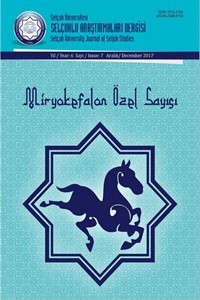Abstract
The existence of human being in Konya goes back 1 million years and demonstrates the history of the region within the Anatolian History. Konya region where the routes from the east, west, north and south meet, forms not only the transportation but also the settlement with its fertile plains and water resources. Konya city (Ikkuwaniya) in the centre of the Konya plain which has a past of 5000 years is also the meeting centre of cultures with its political, religious and commercial identity in addition to be a transition region. Therefore the region became a target for its neighbours or further global political powers. The city was also attacked quite a lot times and pillaged in the Ancient period.
The region gained more importance since the trade routes going to İstanbul were passing through Konya as a result of the Muslims’ conquests of the certain religious centres, especially Jerusalem, in the Eastern Mediterranean in the 7th century in the Medieval Age. Konya, which drew attention as a border city like a military base during the Arab-Byzantine wars, gained a pivotal city status when Turks conquered the region.
For this reason, the transportation network in Konya, which was a passage corridor among the imperial centres earlier, became more centralized in this period. To get an idea of the importance of the region, the transportation network around Konya for ten thousand years, from the Neolithic Age to the Hittite, Phrygian, Lydian, Persian, Hellenistic and Roman Period, will be mentioned, and then the geopolitics of Balkayalar-Bağırşık Stream Fortress, which has been considered as Myriokephalon recently, will be discussed.
References
- Alçiçek, M.C. ve diğ., Homo erectus paleoenvironments in the early Pleistocene Denizli Basin, SW Anatolia, Conference: Colloque Q10. AFEQ CNFINQUA Paléoclimats et environnements quaternaires, quoi de neuf sous le soleil?, At Bordeaux. 2016. İnternet kaynağı: https://www.researchgate.net/profile/Ahmet_Aytek/publication/317342280_Homo_erectus_Subsistence_in_Anatolia_Fossils_and_Tools/links/59347dee0f7e9beee7ccc56d/Homo-erectus-Subsistence-in-Anatolia-Fossils-and-Tools.pdf erişim tarihi: 18.10.2017
- Alp, Gürbüz, “Frigler”, Konya, Haz.Feyzi Halıcı, 41-44/XXXIV-XXXII.
- Bahar, Hasan, “Konya ve Çevresi Tarih Araştırmaları”, Selçuk Üniversitesi Fen-Edebiyat Fakültesi Edebiyat Dergisi, 1994-1995,9-10.s.219-246.
- Bahar, Hasan, ”Tarhuntaşşa Araştırmaları 1994-2002,” V. Uluslararası Hititoloji Kongresi Bildirileri, Çorum 02-08 Eylül 2002, Acts of Vth International Congress of Hittitology, Ankara 2005, s.83-118.
- Bahar, Hasan, Demir Çağında Konya ve Çevresi, Sel-Ün Vakfı Yayınları, Konya 1999.
- Bahar, Hasan, Konya’nın Kırk Höyüğü, Konya Büyükşehir Belediyesi, Konya 2015.
- Bahar, Hasan ve Özdemir Koçak, “Western Links of the Lykaonia plain in the Chacolithic and Early Bronze Age”, XI. Institut Français D’etodes Anatoliennes-Georges Dumezil, De Boccard,Paris 2003, s.21-52.
- Bahar, Hasan ve Özdemir Koçak, Eskiçağ Konya Araştırmaları 2, Neolitik Çağdan Roma Dönemi Sonuna Kadar, Kömen, Konya. 2004,.
- Eskikurt, Adnan, “Myriokephalon Savaşı’na Dair Kronikler ve Modern Çalışmalar”, Chronicles and Modern Reseaches Related with Myriokephalon Battle”, USAD, Bahar 2017; (6): 65-94.
- French, David, “Pre- and Early-Roman Roads of Asia Minor. The Persian Royal Road Author(s)” Iran, British Institute of Persian Studies, 36,1998, s.15-43,
- Haldon, Jhon F., Warfare, State and Society in the Byzantine World, Psychology Press, 1999.
- Hendy, Michael F., Studies in the Byzantine Monetary Economy, c.300-1450.
- Khoniates, Niketas, Historia,Ioannes ve Manuel Komnenos Devirleri, (Çev.. Fikret Işıltan, Türk Tarik Kurumu. Ankara 1995.
- Ramsay, W. M. Ramsay,Notes and Inscriptions from Asia Minor (III), The American Journal of Archaeology and of the History of the Fine Arts, Archaeological Institute of America 2, 2 (Apr. - Jun., 1886), s. 123-131;
- Süryanî Mihael, The Chronicle of Michael the Great, Patriarch of the Syrians (trc. Robert Bedrosian), Sources of the Armenian Tradition, Long Branch, N. J., 2013.
Abstract
Keywords
References
- Alçiçek, M.C. ve diğ., Homo erectus paleoenvironments in the early Pleistocene Denizli Basin, SW Anatolia, Conference: Colloque Q10. AFEQ CNFINQUA Paléoclimats et environnements quaternaires, quoi de neuf sous le soleil?, At Bordeaux. 2016. İnternet kaynağı: https://www.researchgate.net/profile/Ahmet_Aytek/publication/317342280_Homo_erectus_Subsistence_in_Anatolia_Fossils_and_Tools/links/59347dee0f7e9beee7ccc56d/Homo-erectus-Subsistence-in-Anatolia-Fossils-and-Tools.pdf erişim tarihi: 18.10.2017
- Alp, Gürbüz, “Frigler”, Konya, Haz.Feyzi Halıcı, 41-44/XXXIV-XXXII.
- Bahar, Hasan, “Konya ve Çevresi Tarih Araştırmaları”, Selçuk Üniversitesi Fen-Edebiyat Fakültesi Edebiyat Dergisi, 1994-1995,9-10.s.219-246.
- Bahar, Hasan, ”Tarhuntaşşa Araştırmaları 1994-2002,” V. Uluslararası Hititoloji Kongresi Bildirileri, Çorum 02-08 Eylül 2002, Acts of Vth International Congress of Hittitology, Ankara 2005, s.83-118.
- Bahar, Hasan, Demir Çağında Konya ve Çevresi, Sel-Ün Vakfı Yayınları, Konya 1999.
- Bahar, Hasan, Konya’nın Kırk Höyüğü, Konya Büyükşehir Belediyesi, Konya 2015.
- Bahar, Hasan ve Özdemir Koçak, “Western Links of the Lykaonia plain in the Chacolithic and Early Bronze Age”, XI. Institut Français D’etodes Anatoliennes-Georges Dumezil, De Boccard,Paris 2003, s.21-52.
- Bahar, Hasan ve Özdemir Koçak, Eskiçağ Konya Araştırmaları 2, Neolitik Çağdan Roma Dönemi Sonuna Kadar, Kömen, Konya. 2004,.
- Eskikurt, Adnan, “Myriokephalon Savaşı’na Dair Kronikler ve Modern Çalışmalar”, Chronicles and Modern Reseaches Related with Myriokephalon Battle”, USAD, Bahar 2017; (6): 65-94.
- French, David, “Pre- and Early-Roman Roads of Asia Minor. The Persian Royal Road Author(s)” Iran, British Institute of Persian Studies, 36,1998, s.15-43,
- Haldon, Jhon F., Warfare, State and Society in the Byzantine World, Psychology Press, 1999.
- Hendy, Michael F., Studies in the Byzantine Monetary Economy, c.300-1450.
- Khoniates, Niketas, Historia,Ioannes ve Manuel Komnenos Devirleri, (Çev.. Fikret Işıltan, Türk Tarik Kurumu. Ankara 1995.
- Ramsay, W. M. Ramsay,Notes and Inscriptions from Asia Minor (III), The American Journal of Archaeology and of the History of the Fine Arts, Archaeological Institute of America 2, 2 (Apr. - Jun., 1886), s. 123-131;
- Süryanî Mihael, The Chronicle of Michael the Great, Patriarch of the Syrians (trc. Robert Bedrosian), Sources of the Armenian Tradition, Long Branch, N. J., 2013.
Details
| Primary Language | Turkish |
|---|---|
| Journal Section | Articles |
| Authors | |
| Publication Date | September 27, 2018 |
| Published in Issue | Year 2017 Issue: 7 |
Cite
Selçuk University Journal of Seljuk Studies is licensed under a Creative Commons Attribution-NonCommercial 4.0 International License (CC BY NC).

